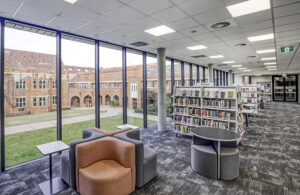 Cheap furniture might save money today – but it could cost a library its credibility tomorrow.
Cheap furniture might save money today – but it could cost a library its credibility tomorrow.
In a time when libraries are stepping up as champions of literacy, inclusion, and community well-being, the choices made in these spaces speak volumes. The Australian Furniture Association agrees that while adopting sustainable practices is a step in the right direction, there’s a widening gap between good intentions and meaningful action – especially when it comes to furniture and fit-out decisions.
Too often, short-term savings lead to long-term consequences, poorly made pieces that break, pollute, and quickly end up in landfill. The result? Higher costs, safety risks, and a contradiction to a library’s mission.
As trusted custodians of knowledge and progress, libraries have a unique responsibility to lead by example—not just in what they provide, but in how they’re built. The path to truly sustainable spaces starts with smarter, more intentional choices. Here’s how to ensure your library isn’t just part of the conversation – but setting the standard.
Fast Furniture: Avoiding Short-Term Solutions
In the quest for cost-effectiveness, libraries might turn to fast furniture—cheap, mass-produced seating and tables typically imported from overseas. While these options may seem economical upfront, they come with hidden costs. Fast furniture is known for its low durability and minimal warranties, often failing to withstand the rigors of library use. Many have limited weight ratings. Who’s going to tell people who look like they weigh over 100kgs that they cannot sit on a specific chair as they enter the library?
The environmental footprint of manufacturing and transporting these items across continents adds to their sustainability drawbacks. Additionally, fast furniture is often designed for domestic use and may not be “fit for purpose” in a library setting. If staff or visitors have an accident due to breakage, it could adversely affect your public liability insurance.
What to Look For: Unlike fast furniture, which tends to last only 1-2 years, sustainable furniture typically includes a long warranty—look for 10 years or more. Your selection should feature commercial-grade fabric, high-density foam, and a sturdy frame.
Australian-made furniture supports local industries and adheres to stringent environmental and labour standards. Purchasing locally manufactured pieces reduces the environmental impacts associated with overseas imports.
When choosing library furniture, it’s crucial to compare “apples with apples.” Fast furniture often represents a “false economy”—both financially and environmentally. Its shorter lifespan means more frequent replacements compared to the durability of sustainable furniture, resulting in higher costs and increased environmental impact over time.
Shelving Quality: From ‘Made in Australia’ to ‘Manufactured in Australia’
Shelving labelled ‘Made in Australia’ may include imported components which are assembled locally. For genuine sustainability, seek shelving that proudly boasts ‘Manufactured in Australia,’ indicating that the entire process—from design to manufacture and assembly—occurs locally.
Sustainable shelving includes lifetime warranties, ensuring longevity and reliability. Additionally, look for certifications such as GECA (Good Environmental Choice Australia).
The Real Cost of Cheap
The upfront price tag of fast furniture might feel like a win, but over time it becomes a false economy. Replacing worn-out or broken pieces every few years increases costs and waste. Sustainable furniture, on the other hand, is an investment in longevity—for your library’s budget, for your users, and for the planet.
In Summary
Libraries are more than just book repositories—they’re community anchors, learning hubs, and increasingly, models of environmental leadership. Choosing durable, sustainable, and locally produced furniture and shelving isn’t just a responsible choice—it’s a powerful statement about the future libraries are helping to build.
For further information contact:
RAECO HERE
